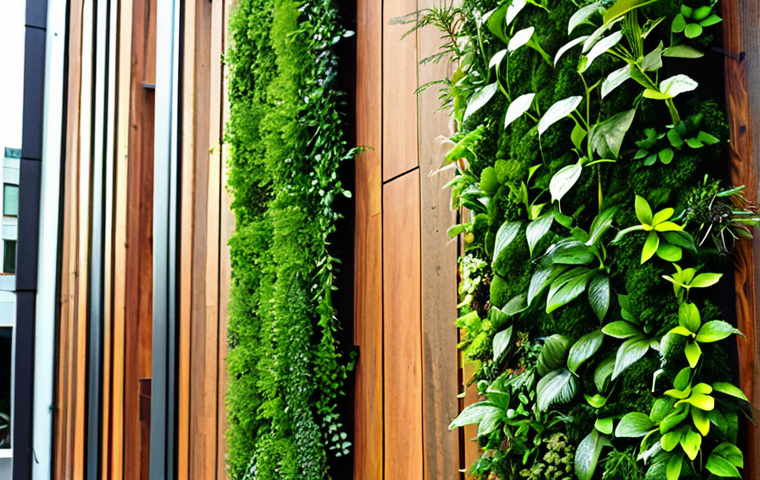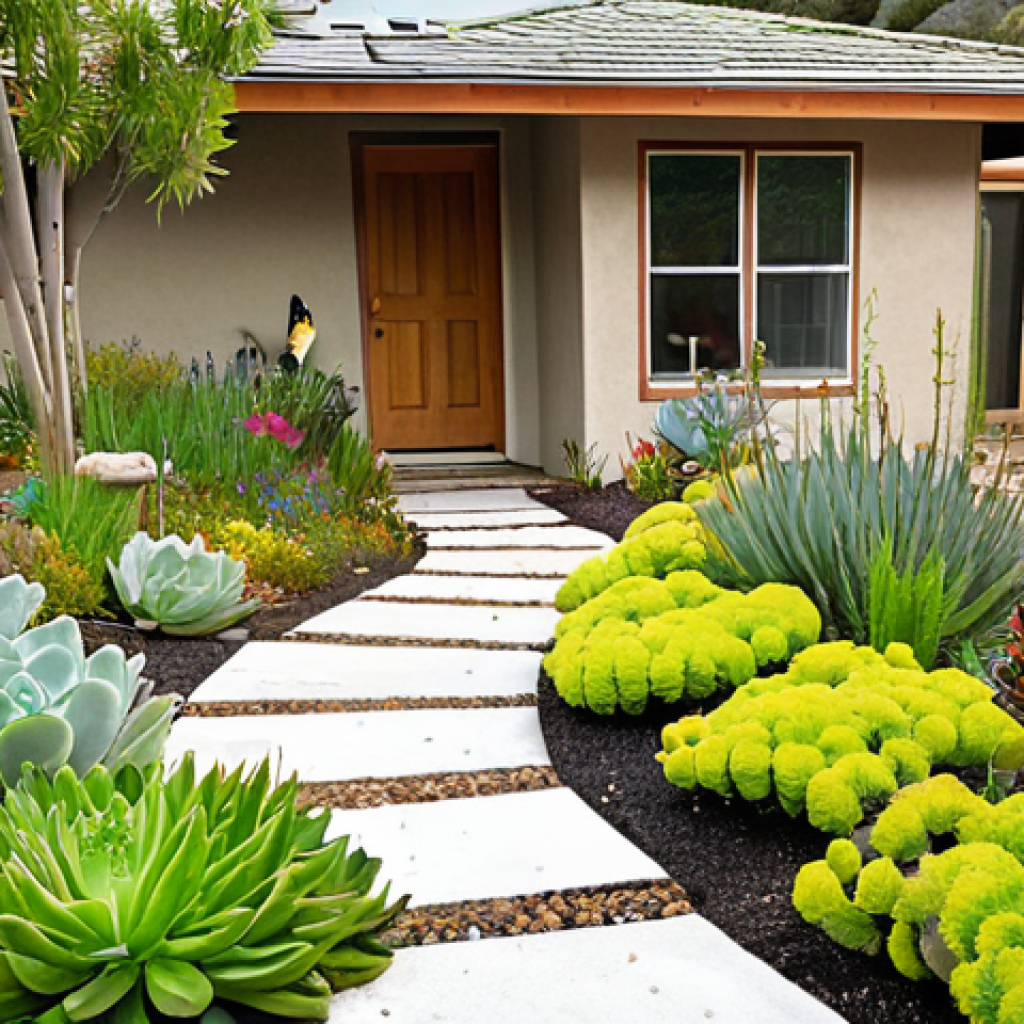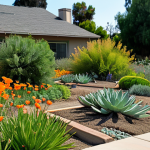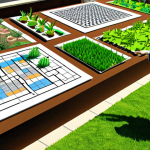The beauty of a well-designed landscape goes far beyond aesthetics; it’s about creating a harmonious relationship between our built environment and the natural world.
I’ve noticed more and more people are valuing eco-friendly designs, incorporating native plants and sustainable materials into their gardens and outdoor spaces.
This isn’t just a trend, but a movement towards a greener, more resilient future, aligning with the global push for environmental responsibility. Plus, from a personal point of view, a well-thought-out garden provides such a calming and restorative atmosphere.
Let’s delve deeper into the world of landscaping and eco-friendly design to better understand!
Alright, let’s dive into expanding this exploration of landscaping and eco-friendly design.
Embracing Native Flora: A Symphony of Local Ecosystems

Integrating native plants into your landscaping design isn’t merely a fashionable choice; it’s a responsible one that resonates deeply with environmental stewardship.
I remember when I first started converting my own garden. I replaced the usual array of exotic, water-guzzling ornamentals with indigenous species. It was like flipping a switch!
Butterflies and bees, previously scarce visitors, became regular guests. This is because native plants have evolved alongside local wildlife, offering vital food and shelter.
They are also uniquely adapted to the local climate, requiring less water, fertilizer, and pesticides – a huge win for both the environment and your wallet.
Unlocking Biodiversity Hotspots
1. Attracting Pollinators: Native plants are magnets for pollinators like bees, butterflies, and hummingbirds, which are crucial for the health of our ecosystems.
2. Reducing Water Consumption: By using plants adapted to your local rainfall patterns, you dramatically reduce the need for irrigation, conserving precious water resources.
3. Minimizing Chemical Use: Native plants are naturally resistant to local pests and diseases, eliminating the need for harmful chemicals that can pollute our soil and water.
Creating a Sense of Place
The cool thing about native flora is that it connects your outdoor space to the broader regional landscape. I mean, it creates a unique sense of place that reflects the natural beauty of your area.
Think about it: a garden filled with native wildflowers evokes the spirit of the prairie, while a woodland garden captures the tranquility of the forest.
I once visited a garden in Arizona filled with cacti and succulents. It was such a stark contrast to the lush, green gardens I was used to, but it was absolutely captivating.
That’s the power of native plants.
Sustainable Hardscaping: Building with Conscience
Hardscaping, which involves non-living elements like patios, walkways, and retaining walls, often gets overlooked in the eco-friendly design conversation.
But selecting sustainable materials and construction techniques can significantly reduce your environmental impact. Consider using reclaimed wood, recycled concrete, or locally sourced stone for your hardscaping projects.
These materials not only add character to your landscape but also minimize the carbon footprint associated with transportation and manufacturing. When I redid my patio last year, I opted for pavers made from recycled plastic.
Honestly, I was surprised by how durable and attractive they were!
Choosing the Right Materials
1. Reclaimed Wood: Salvaged wood from old buildings or demolition sites adds a rustic charm and reduces the demand for new lumber. 2.
Recycled Concrete: Crushed concrete from demolition projects can be used as a base for patios, walkways, and driveways, diverting waste from landfills.
3. Permeable Pavers: These pavers allow rainwater to seep into the ground, reducing runoff and replenishing groundwater supplies.
Construction Techniques for a Greener Footprint
Beyond material selection, construction methods play a huge role in sustainability. Minimizing soil disturbance, using hand tools instead of heavy machinery, and implementing proper erosion control measures can all contribute to a more eco-friendly project.
Water-Wise Landscaping: Conserving Our Most Precious Resource
Water conservation is absolutely crucial, especially in regions facing drought or water scarcity. Xeriscaping, a landscaping approach that minimizes water use, is a great option.
Think gravel mulches, drought-tolerant plants, and efficient irrigation systems. I’ve seen homes transform their thirsty lawns into gorgeous, water-wise landscapes by replacing turf with native groundcovers and installing drip irrigation.
The key is to group plants with similar water needs together and mulch generously to reduce evaporation.
Smart Irrigation Solutions
1. Drip Irrigation: Delivers water directly to plant roots, minimizing water loss from evaporation and runoff. 2.
Rainwater Harvesting: Collects rainwater from roofs and stores it in tanks for later use in irrigation. 3. Smart Controllers: Use weather data and soil moisture sensors to automatically adjust irrigation schedules based on actual plant needs.
Plant Selection for Arid Climates
Choosing plants that are naturally adapted to dry conditions is essential for water-wise landscaping. Succulents, cacti, and native grasses are all excellent choices for arid climates.
They not only require less water but also add unique textures and colors to the landscape.
Creating Wildlife Habitats: Inviting Nature In
One of the most rewarding aspects of eco-friendly landscaping is creating a haven for wildlife. By providing food, water, shelter, and nesting sites, you can attract a variety of birds, butterflies, and other beneficial creatures to your yard.
Planting native trees and shrubs, installing a birdbath, and creating a brush pile are all simple ways to enhance wildlife habitat. I remember when I added a small pond to my garden.
It wasn’t long before frogs, dragonflies, and even a few turtles showed up!
Elements of a Wildlife-Friendly Landscape
1. Food: Native plants provide food for pollinators, birds, and other wildlife. 2.
Water: A birdbath, pond, or stream provides a source of water for drinking and bathing. 3. Shelter: Trees, shrubs, and groundcovers provide shelter from the elements and predators.
Supporting Local Ecosystems
I think the best part about creating a wildlife habitat is knowing that you’re contributing to the health of your local ecosystem. I mean, you’re providing vital resources for animals that are struggling to survive in an increasingly urbanized world.
The Power of Composting: Recycling Organic Waste
Composting is a simple yet powerful way to reduce waste, enrich soil, and create a healthier garden. By composting food scraps, yard waste, and other organic materials, you can create a nutrient-rich amendment for your plants.
I’ve been composting for years, and I’m amazed at how much waste I’ve been able to divert from the landfill. Plus, my plants have never been happier!
Getting Started with Composting
1. Choose a Composting Method: Options include composting bins, tumblers, and worm composting. 2.
Gather Materials: Combine “green” materials (nitrogen-rich) like food scraps and grass clippings with “brown” materials (carbon-rich) like leaves and shredded paper.
3. Maintain the Compost Pile: Turn the pile regularly to aerate it and keep it moist but not soggy.
Benefits of Using Compost
Compost is a powerhouse when it comes to improving soil health. It adds organic matter, improves drainage, and provides essential nutrients for plants.
Using compost in your garden can reduce the need for synthetic fertilizers and pesticides.
Green Roofs and Vertical Gardens: Maximizing Space, Minimizing Impact
In urban environments where space is limited, green roofs and vertical gardens offer creative ways to incorporate plants into the built environment. Green roofs, which are rooftops covered in vegetation, provide insulation, reduce stormwater runoff, and create habitat for wildlife.
Vertical gardens, also known as living walls, can be installed on exterior walls or interior surfaces, adding beauty and improving air quality. I visited a building in downtown Seattle that had a stunning vertical garden covering an entire wall.
It was such a welcome sight in the midst of all the concrete and steel.
Types of Green Roofs
1. Extensive Green Roofs: Lightweight systems with shallow soil depths, suitable for a wide range of buildings. 2.
Intensive Green Roofs: Heavier systems with deeper soil depths, capable of supporting a wider variety of plants, including trees and shrubs. 3. Benefits Beyond AestheticsI think the coolest thing about green roofs is that they provide a lot more benefits than just looking good.
They help regulate building temperatures, reducing energy consumption and lowering utility bills. Plus, they can absorb rainwater, which reduces stormwater runoff and helps prevent flooding.
Maintaining Your Eco-Friendly Landscape: A Long-Term Commitment
Creating an eco-friendly landscape is just the first step; maintaining it requires a long-term commitment to sustainable practices. Avoid using synthetic fertilizers and pesticides, which can harm beneficial insects and pollute waterways.
Instead, opt for organic fertilizers, biological pest control methods, and hand weeding. Regularly mulch your plants to conserve moisture and suppress weeds.
Practices for Sustainable Upkeep
1. Organic Fertilizers: Use compost, manure, or other organic fertilizers to provide nutrients for your plants. 2.
Biological Pest Control: Introduce beneficial insects, such as ladybugs and lacewings, to control pests naturally. 3. Hand Weeding: Remove weeds by hand instead of using herbicides.
By embracing these eco-friendly landscaping practices, you can create a beautiful, sustainable outdoor space that benefits both your community and the planet.
Here’s a table summarizing some key aspects of eco-friendly landscaping:
| Aspect | Description | Benefits |
|---|---|---|
| Native Plants | Plants indigenous to the local area | Reduced water use, attracts pollinators, minimizes chemical use |
| Sustainable Hardscaping | Using reclaimed or recycled materials for patios, walkways, etc. | Reduces waste, minimizes carbon footprint |
| Water-Wise Landscaping | Techniques to conserve water, such as xeriscaping and efficient irrigation | Conserves water, reduces water bills |
| Wildlife Habitat | Providing food, water, and shelter for local wildlife | Supports biodiversity, enhances ecosystem health |
| Composting | Recycling organic waste to create nutrient-rich soil amendment | Reduces waste, improves soil health, reduces need for synthetic fertilizers |
Alright, let’s finalize this deep dive into eco-friendly landscaping.
Wrapping Up
As we wrap up, remember that creating an eco-friendly landscape is a journey, not a destination. Each small change you make—whether it’s planting a native tree or starting a compost pile—contributes to a healthier environment. Embrace the process, experiment with different techniques, and enjoy the beauty and bounty of your sustainable outdoor space. Let’s make our yards havens for both beauty and ecological balance!
Good to Know Information
1. Before you start digging, call 811 to get underground utilities marked. It’s free and it could save your life!2. Check your local zoning ordinances and homeowner association rules before making any major changes to your landscape. You don’t want to get fined or have to undo your hard work.3. When shopping for plants, look for those that are certified as pest-free and disease-free. This will help prevent the spread of invasive species and plant diseases.4. Use a soil test kit to determine the pH and nutrient levels of your soil. This will help you choose the right plants and fertilizers for your garden. You can usually pick these up at your local garden center or hardware store.5. Consider joining a local gardening club or organization. It’s a great way to learn new skills, share ideas, and meet other gardening enthusiasts.
Key Takeaways
* Embrace native plants: They’re adapted to your local climate and require less water and maintenance.
* Choose sustainable materials for hardscaping: Opt for reclaimed wood, recycled concrete, or locally sourced stone.
* Conserve water: Implement water-wise landscaping techniques like xeriscaping and drip irrigation.
* Create wildlife habitats: Provide food, water, and shelter for birds, butterflies, and other beneficial creatures.
* Compost your organic waste: It’s a simple way to reduce waste and enrich your soil.
Frequently Asked Questions (FAQ) 📖
Q: What are some practical ways I can make my landscaping more eco-friendly without breaking the bank?
A: Okay, so going green with your garden doesn’t have to mean a huge investment! From my own experience, one of the easiest and cheapest things you can do is start composting.
Seriously, kitchen scraps and yard waste can become amazing soil boosters. Then, focus on planting native species – they’re already adapted to your local climate, so they need less water and fertilizer.
I remember when I switched out some thirsty non-natives for local wildflowers, and my water bill practically halved! Also, consider reducing your lawn size.
Grass lawns require a lot of maintenance, so replace some of that space with a rock garden, mulch, or even a vegetable garden. I’ve found that integrating more of these elements adds diversity and helps lower your carbon footprint.
Q: I’ve heard a lot about “xeriscaping.” Is that just for desert climates, or can it be used in wetter regions as well?
A: That’s a great question! Xeriscaping definitely has its roots in arid environments, but the principles behind it – water conservation and sustainable landscaping – are relevant pretty much anywhere.
Think of it this way: it’s about choosing plants that thrive in your specific region without needing constant watering. Even in areas with regular rainfall, you can use drought-tolerant varieties and design your landscape to collect and redirect rainwater effectively.
For example, I live in a place with decent rainfall, and I’ve implemented rain gardens to capture runoff from my roof. It’s not about making your yard look like a desert; it’s about smarter water management and choosing the right plants for your microclimate.
Q: How can I attract more wildlife to my eco-friendly garden? I’d love to see more birds and butterflies.
A: Ah, that’s where the fun really begins! Attracting wildlife is all about providing food, water, and shelter. I personally love seeing the birds flock to my garden!
Plant a variety of native trees, shrubs, and flowering plants that provide berries, seeds, and nectar throughout the year. Include plants that host butterfly larvae, too – milkweed for monarchs is a classic example.
A shallow birdbath or a small pond can be a lifesaver for birds and other animals, especially during dry spells. I actually made a simple birdbath from an old terracotta saucer and some rocks.
And don’t be too tidy! Leave some leaf litter and dead branches in the winter to provide habitat for insects and other critters. It’s amazing how quickly a few small changes can transform your garden into a haven for wildlife.
📚 References
Wikipedia Encyclopedia
구글 검색 결과
구글 검색 결과
구글 검색 결과
구글 검색 결과
구글 검색 결과





